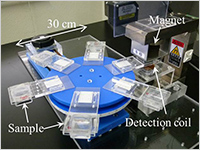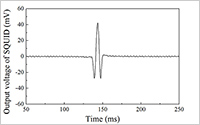Simple, compact, highly sensitive SQUID based magnetic field measurement sysytem to detection of a very small magnetic signals
All materials exhibit unique magnetic properties that are specific to each material. Therefore, we can obtain a lot of information about the material by measuring its reaction to magnetic fields. However, it is difficult to evaluate the magnetic properties of paramagnetic and diamagnetic materials because they show a very small response to the external magnetic fields that is difficult to detect with conventional magnetic sensors. In general superconducting quantum interference devices (SQUID) are the most sensitive magnetic sensor and are used to evaluate the properties of paramagnetic and diamagnetic materials. However, measurement systems using SQUID are large and there are severe limitations on the size and composition of samples that can be measured.
So there is still demand for compact, reliable and simple methods for measuring the magnetic properties of solid and liquid samples.
Here, Kenji Sakai, Toshihiko Kiwa, Keiji Tsukada and colleagues at Okayama University have developed a highly sensitive system for measuring the magnetic properties of magnetics. The system is laptop size despite the incorporating a SQUID sensor, and solid, liquid, and powder samples can be measured by simply putting them in a sample case without any pretreatment (Fig.1).
The researchers successfully used the new system to measure the very small magnetic signal from water due to its diamagnetic nature. (Fig. 2). As an application of this system, the moisture content of a material was evaluated and they found that the magnetic signal intensity of the material depended on the content of water in the material. These results show the new system can be used as a tool for high sensitivity, nondestructive and noncontact measurement of moisture content in materials. Moreover, the researchers also detected a relaxation processes during the magnetic response of materials. This measurement approach is useful to determine the state of materials and detect the individual properties of materials in a mixed solution. The new system is expected to be used in fields, such as nondestructive evaluation and biomedical analysis.
Reference:
・ Authors: Kenji Sakai, Naohiro Okamoto, Yuuta Watanabe. Mohd Mawardi Saari, Toshihiko Kiwa, and Keiji Tsukada
・ Title of original paper: Moisture content evaluation using improved high-Tc SQUID-based rotating-sample magnetometer.
・ Journal, volume, pages and year: IEEE Transactions on Applied Superconductivity, 25, 3, 1601205 (2015).
・ Digital Object Identifier (DOI): 10.1109/TASC.2014.2363353
・ Journal website: http://ieeexplore.ieee.org/stamp/stamp.jsp?arnumber=6926834
・ Affiliations: Graduate School of Natural Science and Technology, Okayama University.
・ Department website: http://www.gnst.okayama-u.ac.jp/index_e.html
Figure caption:
Figure 1 Developed compact and highly sensitive magnetic property evaluation system. The sample is fixed on a turn table and rotated. The signal from a sample is detected by a detection coil inductively connected to SQUID.
Figure 2 Detected magnetic signal from pure water using the developed measurement system. A difference in the output voltage of SQUID was observed at around 150 ms, which corresponds to the time required by the sample to pass above the detection coil.


